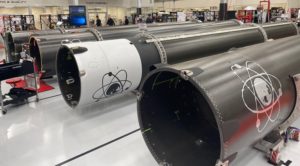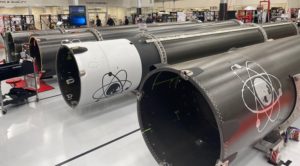WASHINGTON — Rocket Lab says it’s on track to test recovering an Electron booster later this year as it also improves the payload performance of the small launch vehicle.
Rocket Lab announced last week it completed drop tests of a dummy Electron first stage at its New Zealand launch site, demonstrating that its parachute would deploy as expected and slow the booster after reentry.
“We basically simulated the highest load case, where we drop a fully weighted dummy stage out of the sky and accelerate it to the highest load point and then pop the canopy,” Peter Beck, chief executive of Rocket Lab, said during a company webcast Aug. 5 held during the 34th Annual Small Satellite Conference.
Beck said that was the “final test” of the overall recovery system for the Electron first stage, part of an effort the company announced one year earlier to recover and reuse the boosters. Rocket Lab tested on earlier launches the ability of the stage to perform a controlled reentry, as well as using a helicopter to catch the stage as it descends under a parachute.
With the tests complete, Beck said Rocket Lab intends to make its first effort to recover a first stage on an upcoming launch, known as Flight 17 and expected to take place later this year. “That is really the final signoff before we’re ready to go fly Flight 17,” he said. “Flight 17 is sitting in the hangar.” Beck later tweeted a photo of the stage, showing modifications to accommodate the parachute system and other recovery hardware.
The company hasn’t announced a date for the Flight 17 launch. The next Electron launch, which will be a return-to-flight mission after the failure of an Electron launch July 4, is scheduled for later this month and will be the 14th Electron mission. Beck said recently the company expects to resume a monthly launch cadence.
Beck said Rocket Lab won’t attempt to catch the stage in midair on the Flight 17 mission, focusing instead on simply recovering the booster from the ocean. “We’ll fish it out of the ocean, bring it back, put it in the factory and then we’ll really see what we’ve got,” he said. “That will determine how much work we have ahead of us.”
Rocket Lab said last year it decided to pursue reusability in order to increase its launch rate without having to make major investments in increased booster production. “One reuse would be wonderful,” he said.
The company pursued a parachute system after concluding that propulsive landing, which SpaceX uses to recover its Falcon 9 boosters, wouldn’t be effective on a small vehicle. “We needed to let the atmosphere do the majority of the work,” he said. However, the parachutes and other recovery systems do reduce the vehicle’s payload capacity by about 15 kilograms.
That decrease, though, is offset by an improvement in performance elsewhere in the vehicle. The company separately announced last week that increased battery efficiency allowed it to reduce the mass of batteries carried on Electron to power the vehicle, including the electric pumps for its Rutherford engines. That increased Electron’s payload capacity to sun-synchronous orbits from 150 to 200 kilograms and, for lower orbits, from 225 to 300 kilograms, even when accounting for the mass of the recovery systems.
“We bet on battery technology improving over time,” Beck said. “It gives us more capability to do more interesting things.”
Besides the increased payload capacity, the company is now offering a larger payload fairing. During a separate conference webinar, Lars Hoffman, senior vice president of global launch services at Rocket Lab, said the company has created a payload fairing with a diameter of 1.8 meters in addition to its existing 1.2-meter fairing. “A lot of our customers are asking for a little bit greater volume, where mass isn’t the limiting factor,” he said.
The improved performance of Electron, the company noted, also opens up the possibility for using the rocket for interplanetary missions. Rocket Lab won a contract from NASA in February to launch its CAPSTONE cubesat mission to the moon to study the dynamics of the near-rectilinear halo orbit that the agency plans to use for its lunar Gateway.
Beck said in the webinar he’s personally interested in a smallsat mission to Venus, and has been studying a concept for a privately funded mission that could launch in 2023 using Electron. Planetary scientists, he noted, have hypothesized that a region in the planet’s upper atmosphere could be hospitable to life, despite the extreme temperature and pressure at the planet’s surface.
“We’re going to learn a lot on the way there and we’re going to have a crack at seeing if we can discover what’s in that atmospheric zone,” he said. “Who knows? We may hit the jackpot.”
Commercial
Launch
Small Satellite Conference
ElectronReusabilityRocket LabSmall launch vehicles
– Advertisement –


